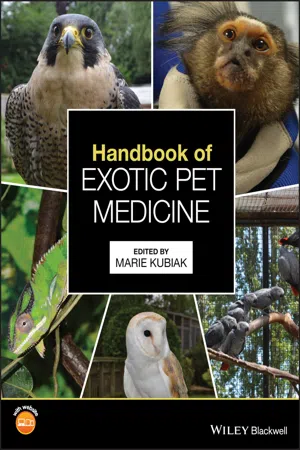
- English
- ePUB (mobile friendly)
- Available on iOS & Android
Handbook of Exotic Pet Medicine
About This Book
Easy-to-use, comprehensive reference covering the less common species encountered in general veterinary practice
Handbook of Exotic Pet Medicine provides easy-to-access, detailed information on a wide variety of exotic species that can be encountered in general veterinary practice.
Offering excellent coverage of topics such as basic techniques, preventative health measures, and a formulary for each species, each chapter uses the same easy-to-follow format so that users can find information quickly while working in the clinic. Presented in full colour, with over 400 photographs, the book gives small animal practitioners the confidence to handle and treat more familiar pets such as budgerigars, African grey parrots, bearded dragons, corn snakes, tortoises, pygmy hedgehogs, hamsters and rats. Other species that may be presented less frequently including skunks, marmosets, sugar gliders, koi carp, chameleons and terrapins are also covered in detail to enable clinicians to quickly access relevant information.
- Provides comprehensive coverage of many exotic pet species that veterinarians may encounter in general practice situations
- Presents evidence-based discussions of topics including biological parameters, husbandry, clinical evaluation, hospitalization requirements, common medical and surgical conditions, radiographic imaging, and more
The Handbook of Exotic Pet Medicine is an ideal one-stop reference for the busy general practitioner seeing the occasional exotic animal, veterinary surgeons with an established exotic animal caseload, veterinary students and veterinary nurses wishing to further their knowledge.
Frequently asked questions
Information
1
Ground Squirrels
1.1 Introduction
1.2 Husbandry
1.2.1 Siberian Chipmunks
1.2.2 Prairie Dogs
Table of contents
- Cover
- Table of Contents
- Title Page
- Copyright Page
- List of Contributors
- Acknowledgments
- About the Companion Website
- 1 Ground Squirrels
- 2 African Pygmy Hedgehogs
- 3 Common Marmosets
- 4 Striped Skunk
- 5 Degus
- 6 Mongolian Gerbils
- 7 Hamsters
- 8 Rats
- 9 Sugar Gliders
- 10 Budgerigars and Cockatiels
- 11 Grey Parrots
- 12 Birds of Prey
- 13 Bearded Dragons
- 14 Geckos
- 15 Chameleons
- 16 Corn Snakes
- 17 Boas and Pythons
- 18 Mediterranean Tortoises
- 19 African Tortoises
- 20 Terrapins
- 21 Amphibians
- 22 Koi Carp
- 23 Tarantulas
- 24 Giant African Land Snails
- Index
- End User License Agreement